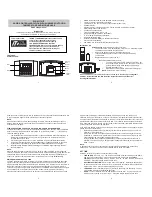
120 20110-100
Gemini/PD Installation Guide
7
2.5 Antenna
To meet the FCC’s RF Exposure Guide-
lines, the main transmitter antenna should
be installed to ensure a minimum distance
between the body of the user or nearby per-
sons and the antenna. To determine the
minimum distance, calculate the antenna
gain less cable loss and refer to the graph
below to identify the required minimum
separation distance.
2.5.1 Recommended tools and
supplies
•
circle cutter
•
hole saw or
•
socket punch for antenna
•
Mini-UHF Crimp tool
2.5.2 Planning
Gemini
PD
commonly uses three separate an-
tennas:
•
Main transceiver – constraints are MPE
limits and omni-directional factors
•
Auxiliary receiver – constraints are di-
versity spacing and omni-directional re-
quirements
•
GPS – constraints are TX spacing and
clear sky view.
For ground-plane dependent antennas –
the center of metal surface is preferable for
best omni-directional pattern.
For ground-plane independent antennas –
installation may be close to the edges of the
surface.
Follow spacing for TX antenna. Install the
antennas in one of the following positions:
-
Most preferred for all antennas: center-
line of roof. For transmitter antenna, it
is the ONLY acceptable position.
-
Less preferred for receiver antenna:
trunk lid, providing distance to trans-
mitting antenna is respected whether lid
is opened or closed.
-
Much less preferred, but permissible for
receiver antenna: left or right rear fend-
ers, just in back of rear window
-
Least preferred, but permissible for re-
ceiver antenna: left or right front fend-
ers, ahead of windshield
Note:
Proximity to other vehicle-mounted
antennas may cause mutual inter-
ference especially at higher fre-
quencies.
Max G(dB) vs distance to accomplish MPE limits
-10
-8
-6
-4
-2
0
2
4
6
8
10
20
7.9
30
11.8
40
15.7
50
19.7
60
23.6
70
27.6
80
31.5
90
35.4
100
39.4
distance to Tx antenna (cm/in)
Overall gain (dB)
(ant. gain -cable loss)
800 MHz
400 MHz(UHF)











































